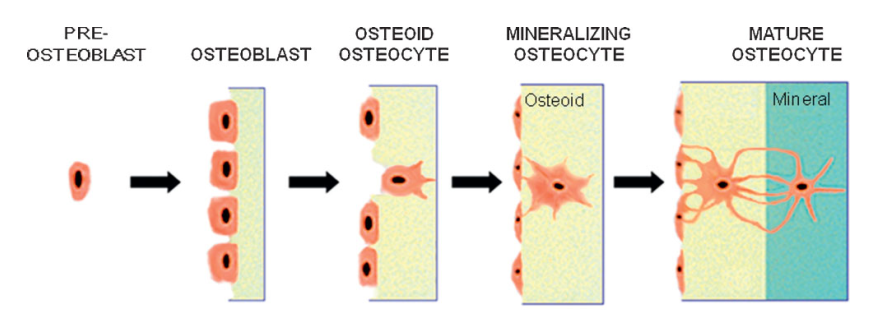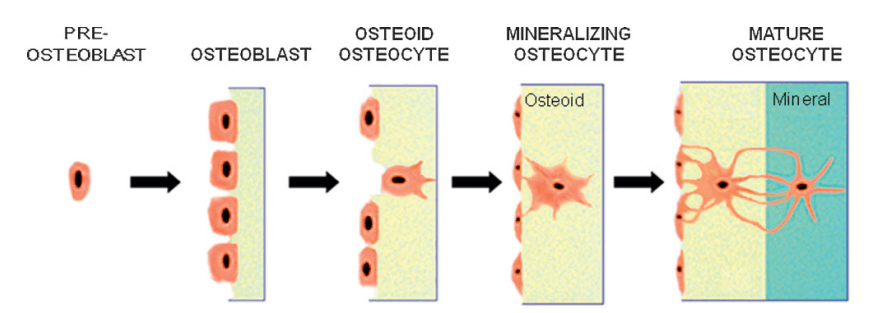Osteocyte Immunology Reagents

Introduction
Osteocyte is the main cell in mature bone tissue, which is derived from bone marrow cells. When the new bone matrix is calcified, the cells are embedded therein. At this point, the cell's synthesis activity stops, and the cytoplasm decreases to become a bone cell. Bone cells can produce a new matrix, change the crystal fluid, so that the bone tissue calcium and phosphorus deposition release in a stable state to maintain blood calcium balance. Osteocytes play a role in bone resorption and bone formation and are the principal cells for maintaining the metabolism of mature bone.

Figure 1. Expression of markers during osteoblast-to-osteocyte ontogeny
Features
The cellular components of bone tissue include osteocytes, osteogenic cells, osteoblasts, and osteoclasts. Only bone cells exist in the bone tissue, and the other three cells are located at the edge of the bone tissue.
The osteocytes are oval-shaped, multi-protuberant cells, and contain a single nucleus that is located toward the vascular side and has one or two nucleoli and a membrane. Under the electron microscope, there were a few lysosomes, mitochondria, and rough endoplasmic reticulum in the cytoplasm, and the Golgi complex was also underdeveloped. Bone cells are sandwiched between adjacent two layers of bone plates or dispersed within the bone plate. There are gap junctions between the projections of adjacent bone cells. In the bone matrix, the small oval cavity occupied by the bone cell body is called the bone lacunae, and the space where the protrusions are located is called the bony canaliculus. Adjacent bone lacunae are interconnected by bone canals. Therefore, osteocytes form an extensive connecting syncytium network via small cytoplasmic/dendritic processes in canaliculi.
Function
Although osteocytes are relatively inert cells, they are capable of molecular synthesis and modification, as well as transmission of signals over long distances, in a way analogous to the nervous system. They are the most common cell type in bone. Most of the receptor activities that play an important role in bone function are present in the mature osteocyte. Osteocytes contain glutamate transporters that produce nerve growth factors after bone fracture, which provides evidence of a sensing and information transfer system. When osteocytes were experimentally destroyed, the bones showed a significant increase in bone resorption, decreased bone formation, trabecular bone loss, and loss of response to unloading.
Osteocytes are thought to be mechanisation cells that control the activity of osteoblasts and osteoclasts within a basic multicellular unit (BMU), a temporary anatomic structure where bone remodeling occurs. Osteocytes generate an inhibitory signal that is passed through their cell processes to osteoblasts for recruitment to enable bone formation.
Osteocyte specific proteins such as sclerostin have been shown to function in mineral metabolism, as well as other molecules such as PHEX, DMP-1, MEPE, and FGF-23, which are highly expressed by osteocytes and regulate phosphate and biomineralization. So the osteocyte is an important regulator of bone mass and a key endocrine regulator of phosphate metabolism.
References:
- Dudley, HR; Spiro, D. The fine structure of bone cells. The Journal of Biophysical and Biochemical Cytology. 1961,11: 627–649.
- Noble, SN. The osteocyte lineage. Archives of Biochemistry and Biophysics. 2008, 473: 106–111.
- Bonewald, L. The Amazing Osteocyte. Journal of Bone and Mineral Research. 2011, 26 (2): 229–238.
- Art
- Causes
- Crafts
- Dance
- Drinks
- Film
- Fitness
- Food
- Spellen
- Gardening
- Health
- Home
- Literature
- Music
- Networking
- Other
- Party
- Religion
- Shopping
- Sports
- Theater
- Wellness
- IT, Cloud, Software and Technology


